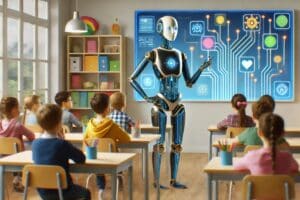
Pooling, cleaning and making sense of data will make us healthier and will give us longevity. Above all, exponential technologies will broaden access to healthcare, progressively including the entire world population, thanks to new capabilities and dramatically lower costs. The advantages of tech need to be assessed from the margin of the empire, indeed, namely by how much new tools are able to liberate those living at the periphery of society. Their data is valuable, and their markets can be unlocked, at least technologically, as we saw in the previous section. There is another immense industry, which will be disrupted by a Total Marketing approach, and that’s the field of education.
Technology has already entered schools and education, via the format of apps, which open to solutions that resemble social media, like in the case of GoStudent (personalized tutoring, including ratings and reviews for students and teachers) or Education First (with the additional elements of community, travel, and continuous training; across all ages).
There is a lot more that we can do, when AI, especially, enters the room. According to the World Economic Forum (WEF) this is a fantastic time to rethink and step-up our education system. This is why the WEF calls it Education 4.0, which rhymes with the other 4.0 labels applied by the institution to the multiple fields of modern stakeholders’ capitalism, as they call it.
Besides the obvious impact of AI, especially in its generative component, on efficiency (for example, bureaucratic tasks and grading, just to name two) and on narrowing the global gap of the millions of teachers needed to cater to the global community, what is intriguing is (1) the ability provide ultra-personalized teaching and mentoring, also via avatars or bots; (2) a modified and living curriculum, which will cover digital skills and coding, the functioning of AI itself (solving problems like AI would do, breaking them down in pieces and working as a team,) plus the hot topics of cybersecurity and data protection; (3) the possibility, in line with the idea of Total Marketing, to pool usage data, continuously, and make sense of them, feeding insights back to students, families, teachers, public institutions, curriculum creators, and so forth, and making the system progressively more efficient and effective. At a regional and international level, more data enables the sharing of best practices faster, and access to education to geographical areas or parts of the population who may sit behind.
From digital textbooks to virtual mentors, from computational thinking to 3D simulators, the pilots illustrated by the WEF in their latest report show increase rates in literacy, higher participation of women in STEM subjects, and a more informed dialogue between the actors who are shaping the school system, from Asia to Africa, to western countries. So far, so good. It does work, it seems. What’s missing is something basic and something extremely ambitious. The basic item is easier to solve: the digital divide is as big as 2.6 billion people without the internet. It is a matter of investments in technical infrastructure. For example, Edison Alliance, a multi-stakeholder non-profit organization, is already working on connecting one billion lives by the end of 2025, via public and private support. The second need is, as mentioned in other chapters of the book, an international alignment on data protection, interaction with AI, and on the definition of how to process and monetize personal data (in this case, especially when we are dealing with under-age students,) so that new value streams can be unlocked, as we integrate AI into the education mix. As human and virtual teachers, we cannot afford to leave our kids alone. We need to protect them from machines and from the secondary agenda of public or private actors, so that they learn how to develop critical thinking, together with their functional skills, and to innovate and challenge the status quo, or socialize and develop their communities further, as we distribute the vast economic rewards of Education 4.0.






















